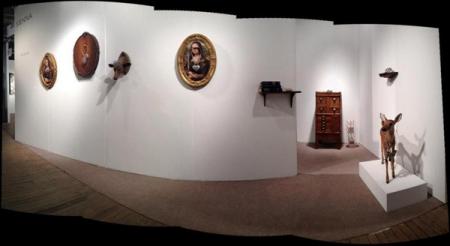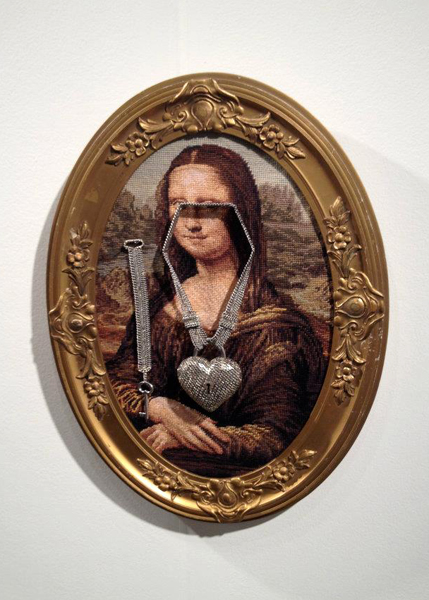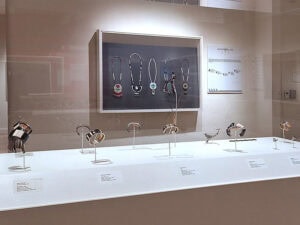
Susan Cummins: Where did you study? Did you have a mentor there?
Lola Brooks: I studied with Myra MImlitsch-Gray and James Bennett at SUNY New Paltz, where I got my BFA. It was inspiring to work with two professors who were as engaged in their pedagogical pursuits as they were in their careers as prolific artists. They were both incredibly influential in shaping me into the artist I am today, sometimes similarly and sometimes in very different ways. I was so fortunate to get to work with James as his assistant for a number of years, cutting my teeth on his gold and learning the finer points of composition among a million other things. We had an incredible working relationship. His material irreverence left its fingerprints all over me and my work, manifesting itself in my flagrant disregard for – and obsession with – conventional notions of preciousness and craftsmanship.
Sienna Gallery located in Lenox, Massachusetts, is owned and run by Sienna Patti, a youngish and ambitious dealer. She grew up in a family atmosphere filled with the ethos of the American craft community and started her business while still in her teens. Sienna is a member of the AJF board and an active member of the international jewelry community. She featured Lola Brooks that the SOFA New York 2012 fair. The show, called charted territories, was installed using furniture and objects taken directly from Lola’s personal holdings. The display added a lot of information about the pieces and about Lola herself, who kindly agreed to answer my questions.

Susan Cummins: Where did you study? Did you have a mentor there?
Lola Brooks: I studied with Myra Mimlitsch-Gray and James Bennett at SUNY New Paltz, where I got my BFA. It was inspiring to work with two professors who were as engaged in their pedagogical pursuits as they were in their careers as prolific artists. They were both incredibly influential in shaping me into the artist I am today, sometimes similarly and sometimes in very different ways. I was so fortunate to get to work with James as his assistant for a number of years, cutting my teeth on his gold and learning the finer points of composition among a million other things. We had an incredible working relationship. His material irreverence left its fingerprints all over me and my work, manifesting itself in my flagrant disregard for – and obsession with – conventional notions of preciousness and craftsmanship.
Myra’s influence has been profound as well, starting with her pulling the rug right out from under me, forcing me to question absolutely every preconceived idea I had about everything from jewelry to teaching methodologies to a myriad of cultural institutions as I naively thought I understood them. I have long considered her work to be among some of the best being made and her conceptual and technical influence continues to show its face in my work, often revealing itself to me only when I step back from a finished piece.
And lastly I would certainly include Sharon Church as an incredible force in my career though technically I was never her student. As inspired as I was by the teaching philosophies of Myra and Jamie while I was in school, it had never really occurred to me that I might be a teacher. But then in 2001 Myra suggested that Sharon consider me for teaching an enameling class at UArts and I guess you could say the rest is history. For the better part of a decade Sharon patiently honed my very rough edges shaping me into the teacher I am today.
It has been an incredible journey.

You are teaching at RISD in Rhode Island and have to give your students assignments to get them to use their imaginations. Can you give me an example of one of those that you think was particularly successful?
Lola Brooks: Working with grad students I am generally loathe to give an actual assignment in any classic sense of the word. But I always love those first couple of weeks of the fall semester, when I have a group of students split between the terrifying unknown territories of the first year at graduate school and the second years who have most likely just found their feet and have now had the space of a summer away to re-masticate the onslaught of information they were privy to in that first year. At this point I am of the opinion that the best assignment is a fast one that will short-circuit their propensity to over-think the work, allowing them to work quickly and intuitively. It is also a great introduction to who they are and how they problem solve. One of my favorites is one I call ‘forty materials.’ They spend the first week collecting, culling, corroborating, claiming, classifying and categorizing 40 materials that captivate them as a maker. This culminates in a visual and conceptual presentation of these materials and a critical discussion the following week. Then choosing a material to explore, they have one week to make anywhere from ten to a hundred pieces, depending on my mood. The results are often quite surprising and it can be fascinating how they define a material.
Can you tell me about your new body of work? How does it relate to your past pieces?
Lola Brooks: The past few bodies of work have all spawned from my fascination with cliché and my general weariness of irony and the perpetual abstraction of everything. I suppose I am a traditionalist in many ways, seeing no reason to invent something brand new when there is all of this incredible depth and richness to be rediscovered in all of these tired old tropes of love, loss, beauty, perfection, femininity, sentimentality or in the ‘jewel’ or a certain type of technical virtuosity for that matter. And this is certainly not to say that I am merely interested in re-presenting these things as they have always been understood, either. I sincerely believe there are profound things to be investigated and reconfigured in these exact territories. And so bows, hearts, knots and roses among other things are all fair game.
As I have continued to root around in the polarities of value between stainless steel and gold, one would think that the spot price might force my hand, but instead I have merely leveraged their relationship by feeding ounces of gold solder into steel chain. The idiocy of this transaction is not lost on me, but I also appreciate the gravity of that decision to do it. It was a terrifying and thrilling act that only deepened my commitment to my materials.
I think in some ways my jewelry has always been allegorical, though in the beginning It seemed really important for me to open up some distance between the inherent historical narrative and the resulting work, which kept me a formalist in many ways and forced a certain level of abstraction on the way I realized my ideas. Now it appears I have tossed out the safety of the abstract in favor of the obvious, in hopes that people may dig a little deeper into what they think they understand, discovering the mysteries that my arrow is aimed at, buried alive somewhere within that saccharine shell of cliché. I don’t know . . . perhaps I am merely picking the low-hanging fruit, but I find that succulent flesh still ripe and tender and sweet and full of surprises.
I know you collect clothes and handbags. Do you think there is any relationship between your jewelry and your collections?
Lola Brooks: I do find power in accumulation; it seems to be an inextricable part of who I am in the world. I collect so many things and there are way too many things to list, but regardless I will indulge myself here with a few of my favorites: vintage rhinestone eyeglasses, needlepoint handbags, plaid pantsuits, anything leopard, underpants in every color of the rainbow, vintage elephant ivory, potted meat food products, vintage wallet sets, gutta percha and then, of course, the drawers to put it all in. I am obsessed with drawers. And I have found that all of it relates directly to my work, deriving from the exact same creative compulsivities. It plays out in the materials I become preoccupied with and then inevitably begin to gather and hoard, the resulting work that consumes those materials, the system of accretion the construction of each piece embodies and then generally into each body of work as a whole, whether I am pursuing a formal thread or a conceptual one from piece to piece. And in my most recent exhibition, charted territories with Sienna Gallery, it played out in the presentation of the work as well.

When you are making work do you imagine how they will be shown? What did you imagine for this group?
Lola Brooks: I have always had big ideas about the installation of my work, but honestly I have never had enough time to pull any of it off, so it has always remained merely a daydream. But this time I had this moment where I looked around my loft, which I both live and work in, and realized I was surrounded by everything I needed to complete the picture I was trying to paint. That my life and my work had merged, an idea I had begun to ruminate on years ago and the tales I spin through my jewelry run parallel to the fairytales I am constantly telling through the objects I surround myself with.
When I was a kid I had this obsession with Mona Lisa in all of her pop-cultural manifestations. She looked like a gal with a secret, or someone who was perpetually up to something. When I was sixteen years old I managed to squirrel enough money away from my paper route to join my humanities class on a trip to Europe that included a visit to the Louvre. I remember appropriating her enigmatic smirk and earning the nickname Mona in response to my wild anticipation of laying eyes on my fair lady. At the museum we stood in a line of people that took over an hour and a half to wend its way past the masterpiece and when I finally caught my glimpse, I was stunned. Where was that heroic scale her omnipresent image had conjured in my imagination? She was so much smaller than I wanted her to be and then so vulnerable that she required a bulletproof box. In my mind she should have been able to deflect her own bullets . . .
Years later it was ebay that rekindled my romance with Mona. This time it was my obsession with the ‘search’ button that brought her back to me. I would type all kinds of crazy things in there just to see what could be bid upon and on that day, for some reason it was ‘needlepoint Mona Lisa’ and boom, there she was in all her glory. I placed a bid and I was proud to hang her on my wall. Her needlepointed smirk took on an entirely new meaning and this time I was in on it. There was something about a rendition of Mona in needlepoint that embodied a certain sincerity that the real had somehow lost in a sea of printed facsimiles. Perhaps it existed in the idea that someone had thought it was important enough to labor for hours over a carefully hand-stitched forgery, translating oil and pigments into wool. Regardless, somehow the authenticity of her needlework had reacquainted me with the authenticity of Leonardo’s paintbrush. And of course what could be better than a needlepoint Mona Lisa? Two needlepoint Mona Lisa’s, or maybe even three. And that is how the idea formed.
When I think about my work I have this sense of gravitas on the one hand and levitas on the other and I wanted to capture the same sentiments in the objects I chose for display: a vacant antique oak taxidermy mount; a 200 year old carved wood deer head I found in India, who had been long separated from the antlers she had been specifically carved to show off; one of Gary Griffin’s rock shelves; the Mona’s; and my antique barrister file drawers – perhaps an intimate psychological invitation to explore my viscera, if one had the instinct to open them. And then I thought about the sweet fragile elegance of a demure taxidermied fawn paired with the weight and scale of a perfectly knotted bow constructed out of lengths of stainless steel chain and ounces of 14-karat gold solder and then I wanted the viewer to have to kneel down in order to experience the piece, face to face with the beauty of a dead thing.
What are you thinking about the idea of beauty?
Lola Brooks: This is such a huge question. I think beauty is the oldest game in town. I think it is such a complex experience that it defies explanation. I have spent the past few years steeped in the annihilating beauty of heartbreak and loss and at times I have wondered if this is the only true location of purity or perfection. But there are those moments of the other kind of beauty too, where it is the lightness and air that are so transformational. I have been told that people find my work beautiful, but for me the transformation occurs while I am making the piece, translating the idea into something tangible, so by the time I am finished the magic has shape-shifted into something very different for me. I have been known to say that I use beauty as a strategy in my work, but it is an arrogance to make such a claim, because the truth of the matter is, beauty is something that cannot be strategized.
Do you listen to music, books, news or nothing when you are making work? What in particular?
Lola Brooks: Actually this changes all the time. It used to be, and I am not sure I should really admit this, that I would listen to soap operas while I worked, The Young & The Restless and The Bold & The Beautiful were two of my favorites, with an occasional episode of Oprah thrown in for good measure. But I have not had a TV for years now, so mostly I listen to music: everything from raunchy rap to Britney Spears, classic rock, disco, opera. It all depends upon my mood and I can be a moody gal if you know what I mean. But I love good stories too, so lately I’ve been listening to anything by Ruth Reichl, because she is a fabulous storyteller. And then I have been getting all of my headline news from podcasts of ‘Wait Wait…Don’t Tell Me!’

Sienna mentioned you have a book by a guy at Bard that influenced this work? What was it?
Lola Brooks: Death in the Dining Room & Other Tales of Victorian Culture, written by Kenneth Ames, is a book that has probably influenced everything I have ever made since I read it. It is a book I discovered my first semester at New Paltz and the result was my very first piece in steel, Chatelaine in 1996. It introduced me to the intricacies and nuances of the Victorian’s social preoccupations and taught me how to understand objects within their given context, both culturally and in more intimate domestic environments. That and an article in Metalsmith from the 1994 summer issue written by Gary Griffin and Erika Stefanutti called ‘Remaking Material’ set up the framework for me to begin to digest the possibility and depth of meaning in absolutely everything around me.
What are you reading of interest right now?
Lola Brooks: Well . . . reading or anticipating reading? The manual to my new Orion mini tig welder has been the only reading I had any time for during the six weeks preceding my show. But I have a growing stack of books waiting for me which includes the following:
The Nutshell Studies of Unexplained Death
Sublime Spaces & Visionary worlds
Still life with Oysters and Lemon
The Poetics of Space
The Hare with the Amber Eyes
Do you make a living from your work?
Lola Brooks: If by my work you mean the art jewelry, the fashion jewelry, the commissions and teaching, then yes I do. The bulk of my income does in fact come from ‘the work’ but the guaranteed monthly paycheck from teaching part-time does insure that I will have at least a portion of my rent covered during months when all of the rest of my endeavors are slow, or I am waiting for checks from the people who represent my work. But that said, I want to be clear that I teach because I am passionate about working with my students. I have built a career by diversifying myself. Perhaps this stems from my mortal fear that having to be overly reliant on any one thing that I love in order to support myself might kill it, but also generally speaking it allows them to take care of each other on the occasions when one cannot care for itself. It is a weird time to be entering the field in many ways. When I began, gold was $300 an ounce, which at the time seemed like an obscene amount of money, but it was still possible to get something off the ground without going deeply into debt to do it. Now with gold at $1600, silver at $28 and cut-throat competition for teaching gigs, it’s a whole different ball game. I think the key is to be really creative about making choices and envisioning what it even means to have a career in this economy. When I look around me it is pretty clear that all the rules have changed.




